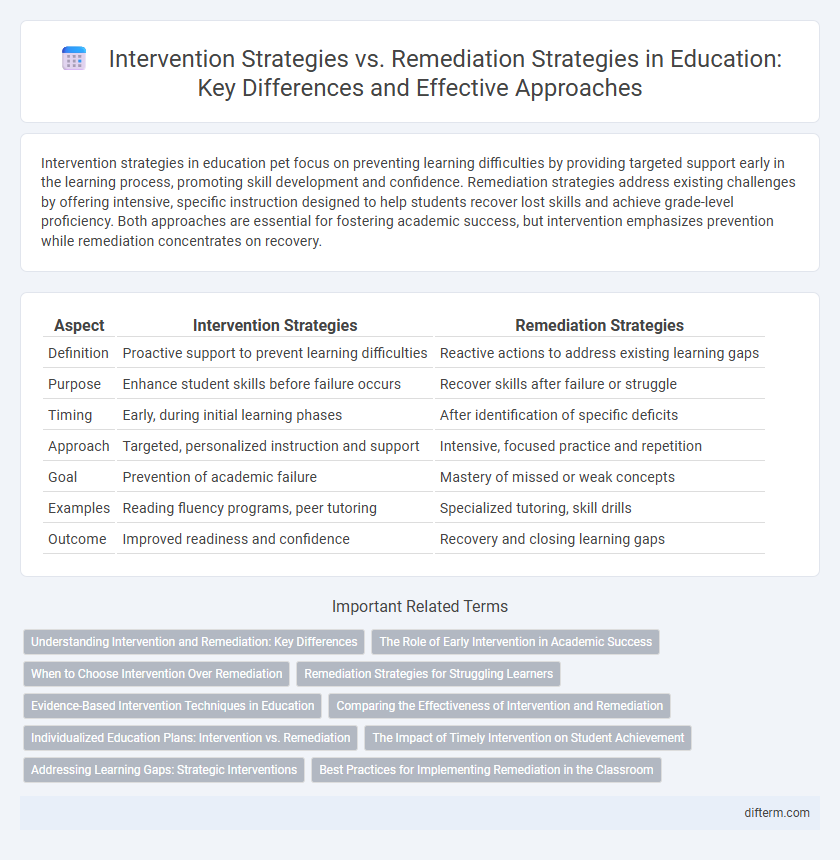Intervention strategies in education pet focus on preventing learning difficulties by providing targeted support early in the learning process, promoting skill development and confidence. Remediation strategies address existing challenges by offering intensive, specific instruction designed to help students recover lost skills and achieve grade-level proficiency. Both approaches are essential for fostering academic success, but intervention emphasizes prevention while remediation concentrates on recovery.
Table of Comparison
| Aspect | Intervention Strategies | Remediation Strategies |
|---|---|---|
| Definition | Proactive support to prevent learning difficulties | Reactive actions to address existing learning gaps |
| Purpose | Enhance student skills before failure occurs | Recover skills after failure or struggle |
| Timing | Early, during initial learning phases | After identification of specific deficits |
| Approach | Targeted, personalized instruction and support | Intensive, focused practice and repetition |
| Goal | Prevention of academic failure | Mastery of missed or weak concepts |
| Examples | Reading fluency programs, peer tutoring | Specialized tutoring, skill drills |
| Outcome | Improved readiness and confidence | Recovery and closing learning gaps |
Understanding Intervention and Remediation: Key Differences
Intervention strategies focus on proactive, targeted support to prevent academic struggles by identifying and addressing learning difficulties early in the educational process. Remediation strategies involve reactive efforts designed to correct and recover skills after significant learning gaps have already developed. Understanding these key differences enables educators to implement timely and effective approaches that cater to students' specific needs and promote long-term academic success.
The Role of Early Intervention in Academic Success
Early intervention strategies target skill development before significant learning delays emerge, enhancing academic success through timely support tailored to individual student needs. Remediation strategies address existing learning gaps, focusing on reinforcing missed concepts to bring students up to grade-level proficiency. Prioritizing early intervention reduces the need for extensive remediation by promoting foundational competence during critical developmental periods.
When to Choose Intervention Over Remediation
Intervention strategies are chosen when students require targeted support to prevent academic decline, often implemented early in the learning process to address specific skill gaps. Remediation strategies are more intensive, suitable for students who have already fallen significantly behind and need comprehensive review to achieve grade-level proficiency. Educators prioritize intervention to promote continuous progress and reduce the need for remediation by addressing challenges promptly.
Remediation Strategies for Struggling Learners
Remediation strategies for struggling learners focus on targeted instruction to address specific skill deficits, often using tailored exercises and repetitive practice to reinforce foundational knowledge. These strategies employ individual or small-group settings to provide scaffolding and immediate feedback, enabling students to catch up with grade-level expectations. Effective remediation emphasizes data-driven instruction and continuous monitoring to ensure progress and adapt interventions accordingly.
Evidence-Based Intervention Techniques in Education
Evidence-based intervention techniques in education prioritize proactive, targeted support designed to prevent learning difficulties by addressing skill gaps early through structured, research-backed methods like explicit instruction and progress monitoring. Intervention strategies focus on enhancing students' foundational skills before significant deficits develop, while remediation strategies aim to correct and recover learning after challenges have emerged, often requiring more intensive, individualized approaches. Implementing evidence-based interventions improves student outcomes by utilizing data-driven practices that adapt to diverse learning needs within inclusive classroom settings.
Comparing the Effectiveness of Intervention and Remediation
Intervention strategies involve proactive measures implemented early to address learning difficulties, while remediation strategies focus on correcting existing deficits after they have become apparent. Studies show that intervention strategies yield higher academic gains by targeting skills before gaps widen, leading to improved long-term outcomes and reduced need for intensive remediation. Effective educational programs prioritize timely intervention to enhance student performance and minimize reliance on remediation efforts.
Individualized Education Plans: Intervention vs. Remediation
Intervention strategies in Individualized Education Plans (IEPs) focus on proactive support to address learning gaps before they hinder academic progress, using targeted teaching methods tailored to a student's specific needs. Remediation strategies, by contrast, aim to correct and recover skills after significant deficits have been identified, often involving repeated practice and reinforcement of foundational concepts. Both approaches are integral to IEPs, with intervention emphasizing early, preventative measures and remediation concentrating on skill recovery to optimize educational outcomes.
The Impact of Timely Intervention on Student Achievement
Timely intervention strategies in education significantly enhance student achievement by addressing learning gaps before they widen, allowing for tailored support that meets individual needs. Intervention focuses on proactive, targeted approaches to reinforce skills and concepts, preventing the necessity for extensive remediation. Early and strategic intervention leads to improved academic outcomes, increased student confidence, and reduced need for resource-intensive remediation efforts later in the learning process.
Addressing Learning Gaps: Strategic Interventions
Intervention strategies focus on proactively supporting students by identifying learning gaps early and providing targeted instruction tailored to specific needs, enhancing skill acquisition before significant deficiencies develop. Remediation strategies aim to address existing learning deficits through intensive, individualized support designed to bring students up to grade-level proficiency. Effective educational programs integrate both approaches to strategically close learning gaps and promote long-term academic success.
Best Practices for Implementing Remediation in the Classroom
Effective remediation strategies in the classroom focus on targeted skill recovery through individualized instruction, frequent progress monitoring, and the use of evidence-based interventions tailored to student deficits. Best practices emphasize early identification of learning gaps, collaboration among educators, and integrating formative assessments to guide instructional adjustments. Consistent use of multisensory approaches and scaffolded supports enhances student engagement and fosters meaningful learning improvements during remediation.
Intervention strategies vs Remediation strategies Infographic

 difterm.com
difterm.com